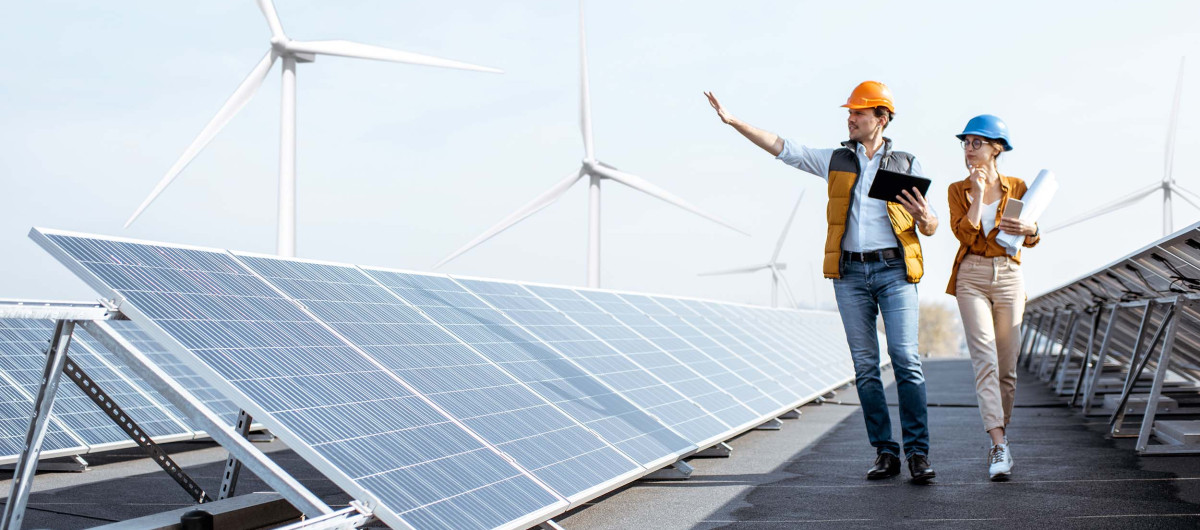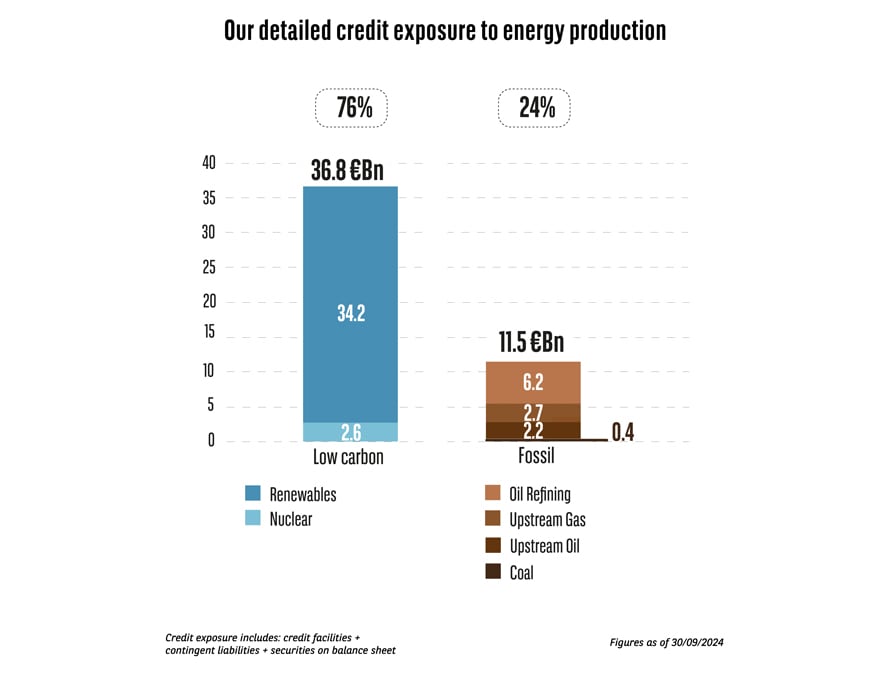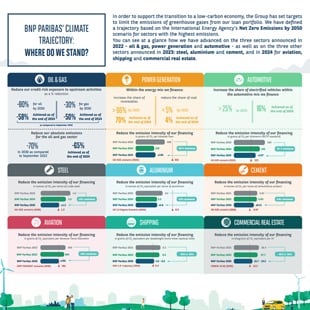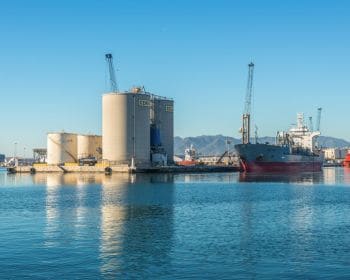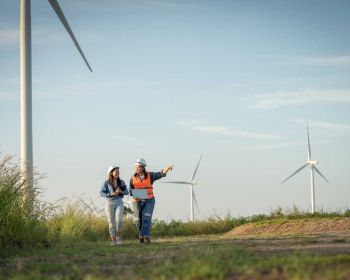Energy transition and climate action
At the very heart of the BNP Paribas Group's raison d'être is its ambition to be a leading player in the movement towards a more sustainable economy. In facing the climate crisis, banks have a major role to play by redirecting financing from the most carbon-intensive energy producers to those creating green energy. As number 1 in the world for green bonds at the end of 2023 * for a second consecutive year, BNP Paribas has shown its strong commitment to contributing to a sustainable economy. How will we continue to do so? Through supporting a multitude of actors and innovations that foster both low-carbon energy and the reduction of CO₂ emissions, driven by a clear purpose: financing a carbon neutral economy in 2050.
Financing the energy transition by supporting low-carbon solutions
For over a decade, BNP Paribas has integrated environmental and social criteria into its financing and investment policies. With the objective to direct its business model towards the support of the energy and ecological transition, by making pioneering commitments to restrict the financing of activities that are most harmful to the environment and the climate.
Investing in low-carbon energy: at least 40 billion euros in financing by 2030
BNP Paribas has already made a major pivot towards financing the production of low-carbon energies: at the end of September 2024, financing to produce low-carbon energies as defined by the International Energy Agency (being 36.8 billion euros, of which 34.2 billion euros was for renewable energies) was already much higher than financing for the production of fossil fuels (11.5 billion euros) thus representing 76% of our credit exposure to the energy production. Supporting our societies and economies towards net-zero is indeed a priority for BNP Paribas. In very concrete terms, this means financing projects in line with our policies and trajectories, as well as with those defined by the European Union, to progressively reduce financing for polluting sectors, while increasing it for their more sustainable alternatives.
The Group's next objective? To have reached at least 40 billion euros in credit exposure for low-carbon by 2030, and especially renewable, energy production, thus completing the transition of more than 90% of its financing activities towards low-carbon energy production.
Three points to remember about BNP Paribas' low-carbon commitments
in credit exposure were dedicated by BNP Paribas to low-carbon energy production as of 30 September 2024
in credit exposure for low-carbon by 2030, and especially renewable, energy production
dedicated to the transition of our clients to a low-carbon economy by 2025
Financing for gas exploration and production will be cut by more than 30% by 2030.
Concerning oil, an intermediate step is planned for 2025, with an objective to reduce our financing for oil exploration and production activities by at least 25% compared to 2020.
A timetable for the complete exit from thermal coal had been set in 2020, with a target date of 2030 in the EU and OECD countries.
In total, financing for energy generation (low-carbon and fossil-based) accounts for less than 3% of BNP Paribas’ total loans to the economy. The Bank is therefore not particularly dependent on the energy production sector, and the pace of its loan portfolio’s transition is mainly linked to the real economy’s transformation capabilities.
Net-zero commitments and trajectory
see the infographicThree key points about the withdrawal from fossil fuels
date when BNP Paribas stopped oil project financing
date of full coal exit in EU and OECD countries
reduction of financing for oil exploration and production by 2030
Supporting innovations and helping our clients finance their transition
By redirecting financing from fossil fuel production to low-carbon energy production and sustainable projects, BNP Paribas plays its part in supporting and accelerating the transition. The automotive industry represents the third most greenhouse gas-emitting sector, and the Group has a targeted reduction in financed carbon intensity of minimum 25% by 2025. In line with the end of the sale of new thermal vehicles in Europe, the Group will also increase its financing dedicated to sustainable mobility and in particular to electric vehicles.
In May 2023, in its Climate Report on 2022, BNP Paribas presented its new portfolio alignment targets for 2030 with three new key sectors: steel (with a target reduction of 25%), cement (-24%) and aluminium (-10%).
In May 2024, in its Climate Report on 2023, the Group announced new targets for three additional sectors: aviation (-18%), shipping (-32% to -23%) and commercial real estate (-41% to -31%).
Focus on a selection of landmark renewable energy projects in Europe and in Americas
An acceleration in the financing of renewable energy production, reflected by major, recent projects as illustrated by the following maps (click on the buttons to view):
A collective move towards net-zero by 2050
To move towards carbon neutrality by 2050, several net zero coalitions have recently emerged. Their goal? Bringing together financial sector actors to contribute to the financing of a net-zero economy by 2050, through strong commitments that align greenhouse gas emissions induced by their own account credit and investment activities.
As a founding member of the Net-Zero Banking Alliance, we are committed to aligning our credit and proprietary investment portfolios with clear objectives and science-based methodologies. Achieving this goal is a challenge not only for BNP Paribas but for the entire banking industry, as no bank can do it alone.
The TCFD: a working group dedicated to climate risk analysis and management
In 2015, the United Nations created the Taskforce on Climate related Financial Disclosures, which aims to improve financial transparency about climate related risks and potentially important opportunities. The recommendations of this body constitute a common international framework for making markets more efficient and strengthening the world's economies in the face of climate change.
Since its creation, BNP Paribas has been a member of the Taskforce and has published a report based on the Taskforce's recommendations since 2020 in order to offer a complete and accessible analysis of the Group's financial information based on four pillars: Governance, Strategy, Risk Management, and Indicators & Objectives.
A series of concrete commitments, especially in the most sensitive sectors
Since 2015, in order to regulate its activities related to the most sensitive sectors and to limit global warming in line with the objectives of the Paris Agreement, BNP Paribas has made many impactful decisions, always consistent - and sometimes in advance - with the objectives defined by the European public authorities. A look at the key dates to note.
Key dates
In February 2024, for its annual results, BNP Paribas moves forward by two years its target of reaching 80% low-carbon in the Group’s financing for energy production: it is now set for 2028. By 2030, the goal will be 90%. In May, The Group announced in its Climate Report on 2023 new portfolio alignment targets for 2030 with three additional sectors: aviation, shipping and commercial real estate.
In May, The Group publishes its Climate Report on 2022: it confirms the trajectories announced in 2022 in the oil and gas, electricity generation and automotive sectors and presents new portfolio alignment targets to 2030 for steel, cement and aluminium.
In January, BNP Paribas embarked on a new phase of strong acceleration in financing for low-carbon energy production and fossil reduction with clear and ambitious objectives. In particular, a 2030 objective has been set to achieve €40 billion in outstanding financing for low-carbon, primarily renewable, energy production by 2030, while at the same time reducing outstanding financing for oil extraction and production to less than €1 billion from the current €5 billion, a reduction of more than 80%.
The Group publishes its first climate analysis and alignment report. It sets ambitious targets for the electricity, oil and gas, and automotive sectors by 2025. It also makes a strong commitment to reduce its exposure to oil production by 25% (compared to 2020) by 2025.
BNP Paribas commits to reducing its exposure to oil and gas exploration and production by 10% by 2025. A target that has since risen to 12%.
BNP Paribas accelerates the timeframe of its complete coal exit: by 2030 in OECD and EU countries, and by 2040 in the rest of the world. This policy has led BNP Paribas to stop providing loans and financial services to around one in two electricity companies worldwide.
BNP Paribas ceases to provide any new financial service to unconventional hydrocarbons specialists (shale gas, shale oil, oil from tar sands, Arctic).
BNP Paribas ceases all new financing of coal fired power plant projects.
BNP Paribas stopped oil project financing.
BNP Paribas commits to progressively align its loan portfolio with the objectives of the Paris Agreement.
Climate Analytics and Alignment report with clear and ambitious targets
After a first Climate Analysis and Alignment Report published in May 2022, BNP Paribas published an even more comprehensive Climate Report in May 2023, including the TCFD report as well. This report presents the Group’s progress and ambitious objectives for the near future—2025 and 2030—involving immediate actions to foster a low-carbon economy in six of the most CO₂-emitting sectors:
- electricity generation, with a share of renewable energy expected to reach 66% by 2025;
- oil and gas exploration and production, with declines of 80% and 30% respectively by 2030;
- automotive, with a quarter of vehicles electrified in the financed powertrain technology mix by 2025;
- steel, with a 25% reduction in emission intensity of financing by 2030;
- aluminium, with a 10% reduction in emission intensity of financing by 2030;
- cement, with a reduction in emission intensity financing of 24% by 2030.
Then, in the Climate Report on 2023 published in May 2024, the Group presented three new sectors with portfolio alignment targets to 2030:
- aviation, with a -18% reduction reduction in emission intensity of financing by 2030;
- shipping, with a -32% to -23% reduction in emission intensity of financing by 2030;
- commercial real estate, with a -41% to -31% reduction in emission intensity of financing by 2030.
These reduction trajectories, most of which are based on the International Energy Agency (IEA) Net-Zero Scenario by 2050, send a strong message to stakeholders that BNP Paribas is fully committed to achieving its emissions reduction targets and supporting its customers in their own transition. This represents a further step forward, and the Group will continue to publish interim targets for reducing CO2 emissions.
*According to Bloomberg

